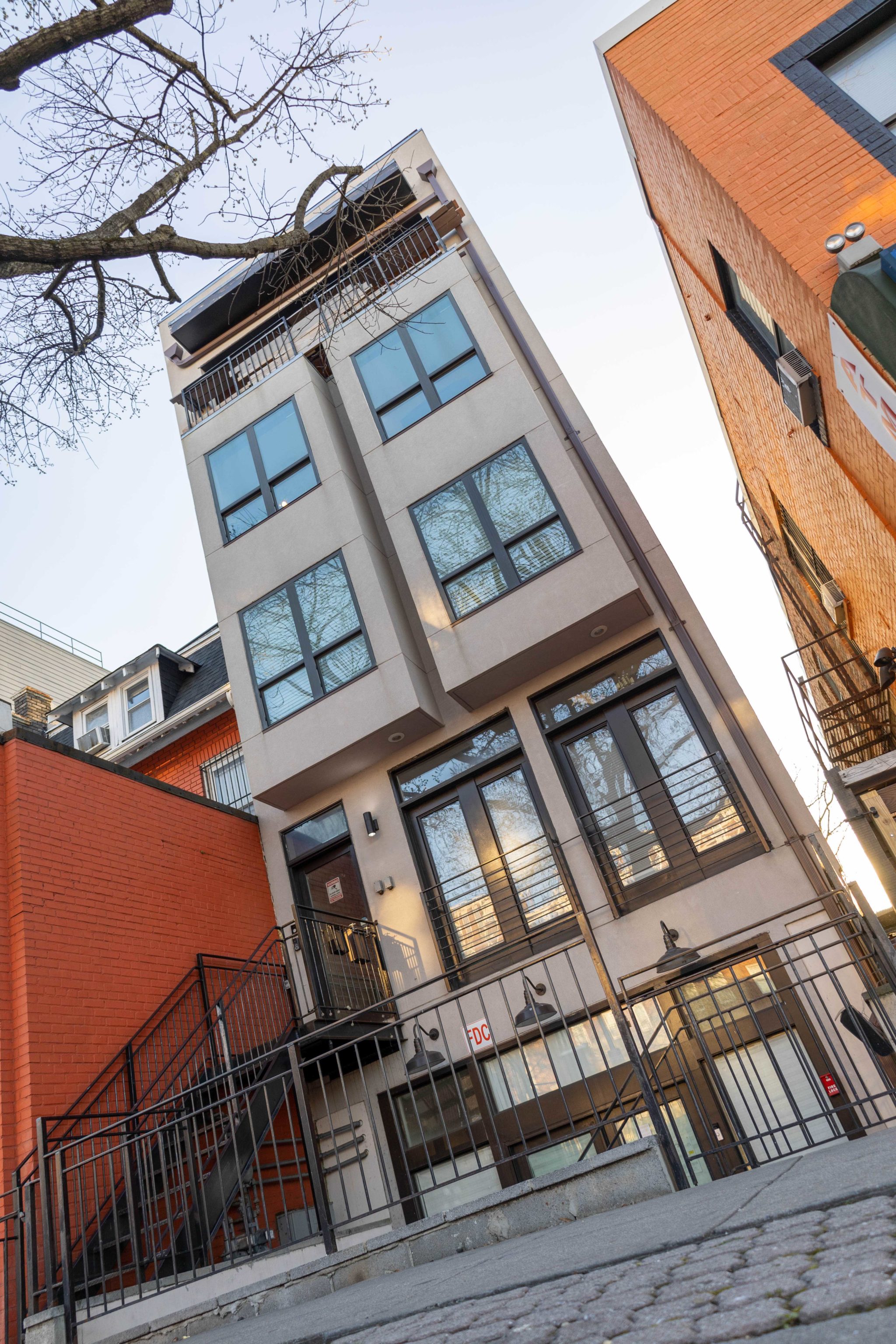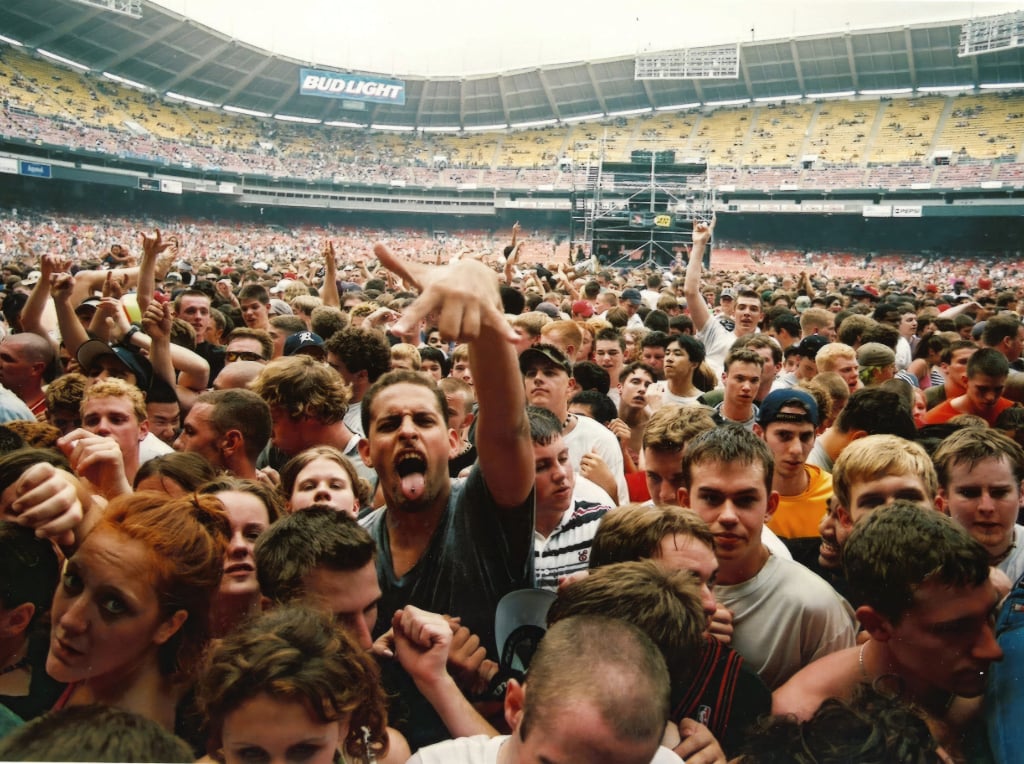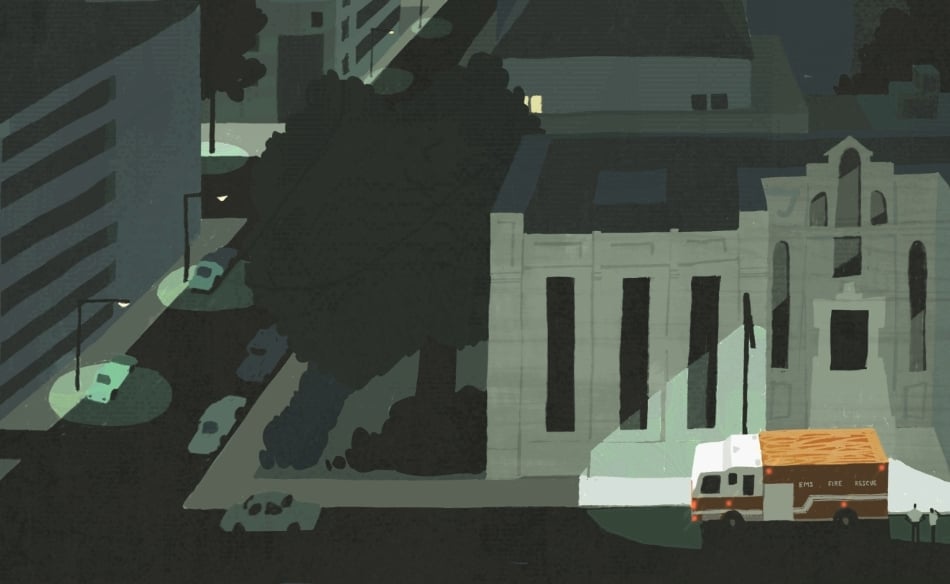On a stormy night in the summer of 2021, Darinka Komljenovic was sitting in the loft-like bedroom of her condo in DC’s Petworth neighborhood when she felt the room start to shake. She looked up and saw the tall potted cactus on her dresser wobbling back and forth. Picture frames clacked against the wall. Downstairs, hanging lights in the kitchen swung like pendulums. The weather stripping around the windows stretched and squeaked. She took out her phone and started recording videos.
The leaks had been bad enough. During rainstorms, water would stream in from cracks in the ceiling, the edges of doors, and the recessed ceiling lights. But the swaying was even more alarming. When a big truck drove down the street, Darinka says, the six-story building near the corner of Georgia Avenue and Taylor Street, Northwest, would tremble—and when wind gusts were strong, Darinka and her brother, Nick, claim in court documents, it would shudder and shake as if enduring its own private earthquake.
Sometimes, the siblings, who together had bought the condo more than a year earlier, would be so afraid the building might collapse that they’d run outside to take refuge in their cars. Or they’d frantically make arrangements to stay with friends, who joked that their own apartment was a storm shelter—except that no one else in the city was taking cover.
Walking by the Komljenovics’ building, you’d never guess it was structurally unsound. Neither a tumbledown rowhouse nor a neglected prewar structure, the sleek gray property was a new construction, completed just months before the siblings moved in. They bought their unit, which occupies the upper floors, for $865,000 in March 2020. Their downstairs neighbors, the building’s only other residents, purchased theirs a few months later for $702,000.
Buying a home is a big deal for anybody, but this was supposed to be one of the happiest milestones for us.
When the Komljenovics bought their condo, the first-time homeowners were thrilled. But over the next three years, their dream home would reveal itself to be nightmarishly defective. The siblings and their neighbors estimate they’ve spent more than $150,000—and counting—on legal fees, contractors, and inspections, and have engaged in a protracted lawsuit against the building’s developer and seller. They’ve also come to realize that the arm of the city government responsible for protecting people like them from shoddy and dangerous construction had arguably failed to do so.
Today, the Komljenovics find themselves stuck in a building that independent inspectors say is unsafe to occupy—one so flawed that their neighbors, a couple originally from India who are both trained as architects, asked Washingtonian not to be named because they worry that being publicly associated with it could hinder their careers.
“Buying a home is a big deal for anybody, but this was supposed to be one of the happiest milestones for us,” Darinka says. “It’s just completely flipped on its head and become the biggest stressor in my life.”
Darinka and Nick were born in Croatia. As Yugoslavia split apart in the 1990s, war broke out, and their father, an ethnic Serb, lost his job, prompting the family to flee the Balkans as refugees. They landed first in Germany, then in Maryland, where a Presbyterian church in Anne Arundel County sponsored them. When they arrived in Glen Burnie in 1999, Darinka was eight years old and Nick was 16.
The siblings spent the rest of their childhood in Maryland and grew to think of the Washington area as home. Darinka went to American University and worked in marketing for Uber for ten years (she also was an advertising intern with Washingtonian in 2012-13), while Nick has worked in finance for more than a decade. By early 2020, both had finally saved enough money for a place of their own. Living together as adult siblings may seem unusual in the US, Darinka says, but she and Nick thought they should pool their resources on a bigger investment than either could afford on their own. They wanted a well-appointed, modern condo—preferably something newly built, with more than one floor for space and privacy.
From the outside, the slate-gray condo building on Georgia Avenue looked much like hundreds of other new-builds in the District, where over the past decade, gentrifying neighborhoods like Petworth, Navy Yard, and NoMa have been at the center of a residential-construction boom. But inside, the unit the Komljenovics ended up buying that March felt airier and more luxurious than any of the other properties they considered. It had two full floors, an open dining/living area with enough space for two people to work comfortably, and a shed-like loft bedroom perched on the roof.

Like many homebuyers in hot markets, the siblings felt somewhat rushed into their purchase—in the hopes of getting a better deal, they waived the chance for an independent inspection of their unit. Still, they assumed that the building’s certificate of occupancy—a District-issued document ensuring that structures meet zoning and building-code requirements and are fire-safe—meant it was in good shape. More than anything else, they felt a sense of achievement about owning a home for the first time. After years of moving around constantly, the siblings, who remembered being refugees, were elated to be settling in.
“I was beyond happy,” Darinka says. “I couldn’t believe I had reached that milestone already, and I knew it made my parents proud.”
Covid restrictions began soon after the move, spoiling Darinka’s plans for a housewarming party. Instead, their mom drove over to decorate with flowers. A plant lover, Darinka began transforming the space with succulents, ficus, and snake plants—drawing inspiration from the greenhouse-like living space, with its floor-to-ceiling glass doors, spacious balconies, and open stairwell. Over time, however, she and Nick began to understand why they hadn’t seen these features in any of the other condos in their price range: They violated the city’s building code.
“There was a lot about this condo that was really unique,” Nick says. “All of these unique things are unique because they’re illegal.”
In April 2020, the Komljenovics say, the first sign of trouble appeared: a ceiling leak. It filled half a container, Nick says, and the siblings soon learned just how many places in a home can leak when it rains and how much damage water can cause. That summer, the homeowners’ suit alleges and photos show, leaks burst from ceiling lights, door frames, and light-switch panels, warping wooden floorboards and turning baseboards to wet, shredded pulp. The building’s clapboard siding, which had sizable gaps in it, was also coming loose. Soon, the ends of the boards peeled away from the wall, protruding haphazardly.
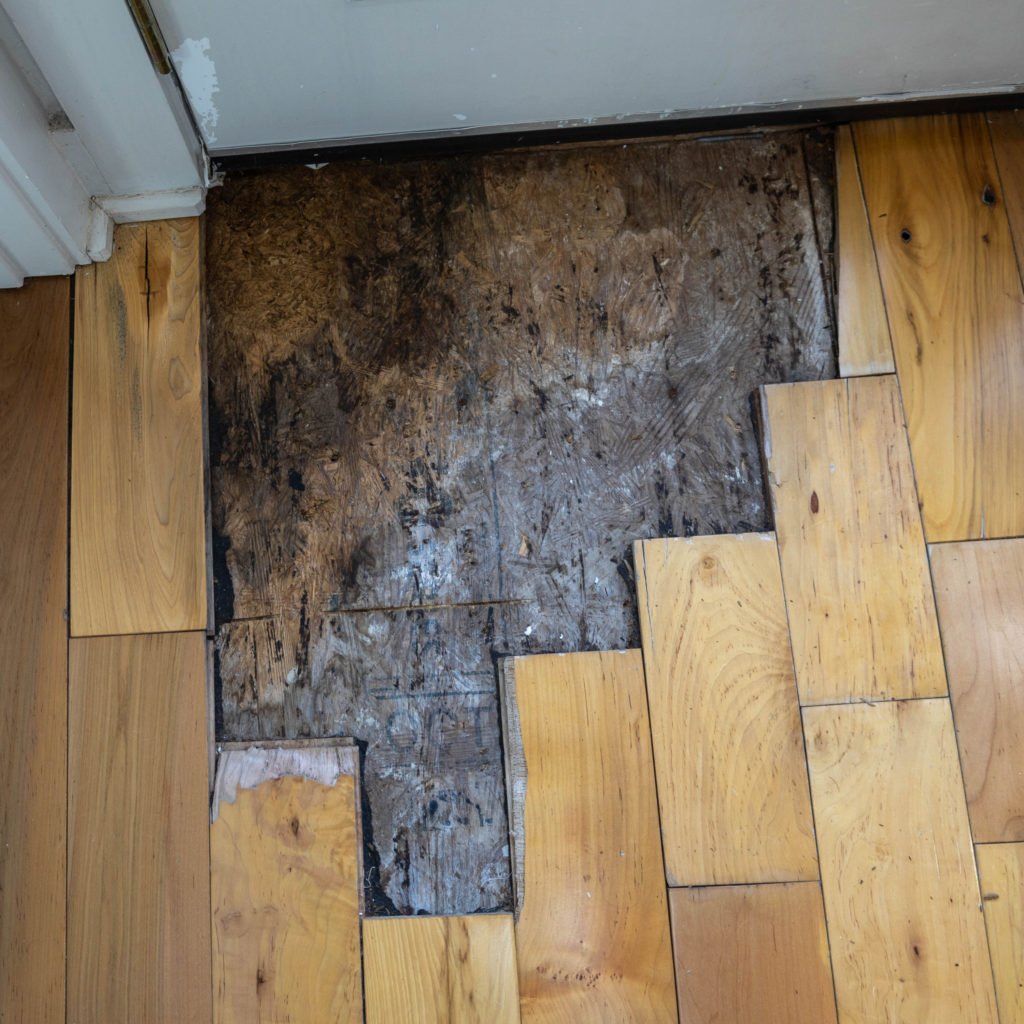
To the siblings, it felt like the building had been built to last just long enough to sell and was now starting to disintegrate. Still, the building’s developer, Dereje “Reggie” Seifu, seemed helpful at first. Based in Petworth, he had several large-scale remodels under his belt. Seifu sent workers to remedy the leaks by installing thin metal flashing around balcony doors and under the top-floor deck. He also sent a siding contractor to visit the building—but more important structural issues precluded fixing that problem.
Meanwhile, the homeowners allege in their lawsuit, Seifu was assuring a second pair of buyers, the architects, that the downstairs unit they had their eye on was built to code. Seifu told Washingtonian he never made that assurance. The Komljenovics’ new downstairs neighbors noticed some minor problems almost as soon as they closed their sale that November—issues that the $500 home inspection they’d paid for hadn’t caught.
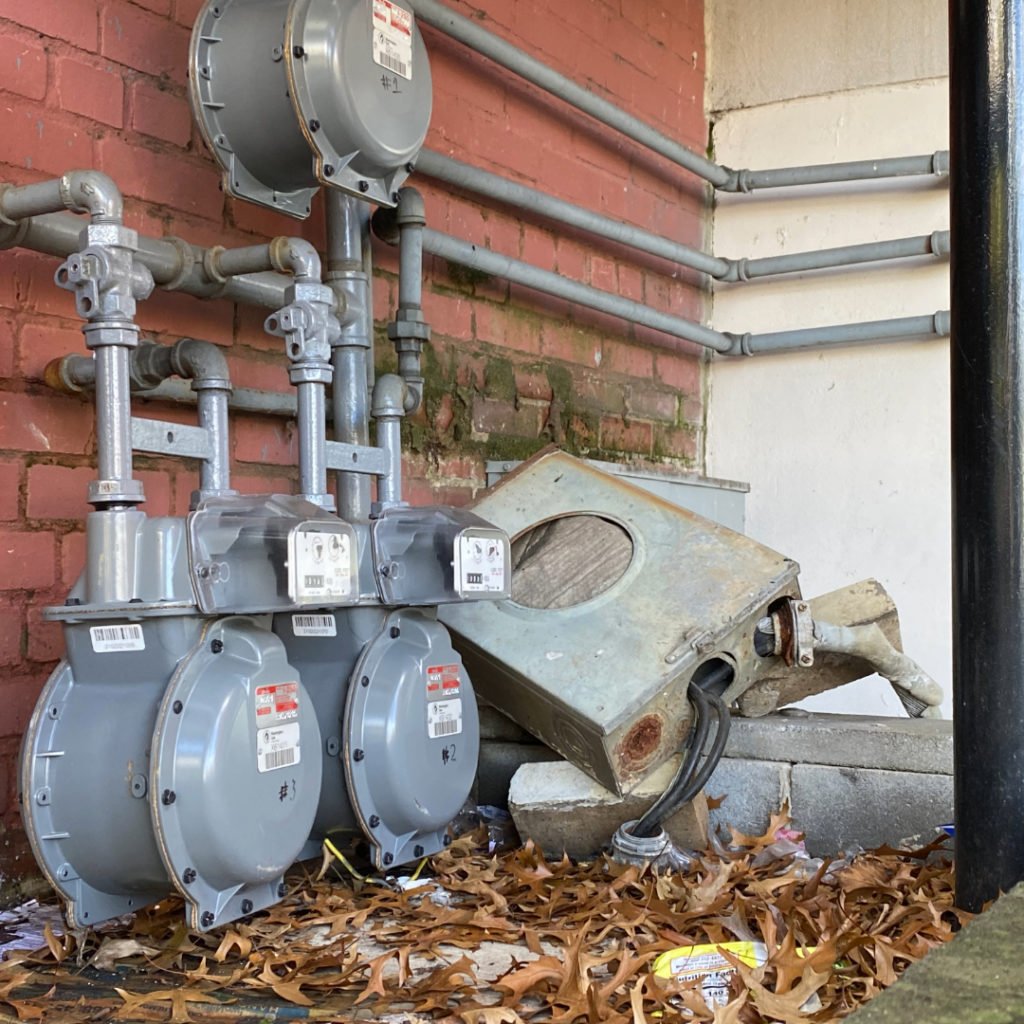
The couple were concerned that the building had no electrical meters. They say Seifu and DC real-estate attorney Steve Sushner, the man who’d sold them their condo, assured them that they’d applied to Pepco and the installation had been temporarily delayed by the pandemic. The new owners also soon complained of malfunctioning appliances and misaligned patio doors that didn’t form a seal when closed. Once they talked to Darinka and Nick—who already felt like roommates because of the thin walls and ceilings—they became seriously concerned.
By the summer of 2021, the problems were beginning to feel intractable and unsafe. None of Seifu’s work had stopped the leaks, the homeowners’ suit alleges, and new ones continued to appear. That March, the suit alleges, Pepco had also informed the homeowners that the building’s electrical connection lacked official meters. The utility was unsure how the building had electricity, and it threatened to shut the power off until its technicians could install the meters, which it said should have been in place from day one.
Even worse, the suit alleges, the building started to sway. The movement could be heard before it was felt. Sit in the upstairs bedroom today and you’ll hear creaks and pops whenever the wind blows, especially at more than 30 miles an hour. As the building swayed, tiny cracks in the walls grew. Nick would patch them, but as the building continued to shift, they’d split again. When Nick and Darinka informed Sushner about the swaying in June 2021, the suit alleges, he told them to hire a structural engineer at their own cost.
“We kept losing confidence in the builder,” Nick says. “And were worried that much more could be wrong with the house.”
The Komljenovics hired Delaine Englebert—a licensed independent building inspector who’d worked as a construction inspector for the District for years—to visit the condo in July 2021. What she found was harrowing. Key aspects of the finished building differed substantially from its plans. A floor-to-ceiling pane of glass, she told the siblings, should have been a reinforced wall. The ceiling heights also extended beyond those specified in the plans, which showed Darinka’s bedroom as a windowless loft space.
I was very scared for those people. You need those braced wall lines to stop the building from moving.
Fire safety was another problem. The interior staircases and doors weren’t fire-resistant or enclosed. The exterior fire-escape stairs were made of combustible materials. The sprinkler system was incomplete, its water line shut off.
Later included in the homeowners’ lawsuit, Englebert’s inspection report found about 70 code violations. The most severe: The building lacked lateral bracing for its exterior walls, causing it to sway. Without this bracing, relatively weak door frames and interior partition walls were load-bearing, holding up the weight of the structure without adequate support. “I was very scared for those people,” Englebert says. “You need those braced wall lines to stop the building from moving. If that building were to rock in the right direction, it could fall over on itself.”
Englebert warned the siblings that the building would eventually collapse, “flattening like a pancake.” On July 26, four days after Englebert finished her report, a severe storm hit DC, causing what felt like an earthquake in the upstairs apartment. That was the night Darinka, in a panic, shot a video of the cactus jiggling on her dresser like a bobblehead.
As a result of her intense stress at home, Darinka says, she underperformed at work and lost her job at Uber. Once, on a work call, Nick had to excuse himself because his house was shaking. He eventually quit his job to devote all his time to understanding just how he and his sister had gotten into this mess—and how they might get out of it.
The District’s Department of Buildings is responsible for keeping the people living in DC’s rowhouses, condos, office buildings, and myriad other structures safe. The agency has many responsibilities: issuing building permits, performing housing-code inspections, stopping illegal construction, and enforcing zoning laws, among others. Until 2020, DOB’s functions were handled by the city’s Department of Consumer and Regulatory Affairs, which also regulates businesses and enforces consumer protections.
Construction permits were still the responsibility of DCRA when Seifu began work on the Georgia Avenue condo. Seifu applied for and received a demolition permit in January 2016, taking down a two-story single-family home that had occupied the property. He then applied for a building permit and submitted building plans for the new property, but he never received the permit before forging ahead with construction. The building would be almost complete before DCRA finally issued a building permit retroactively two years later, in May 2018.
In the meantime, the construction site turned deadly. On January 18, 2017, a construction worker, Pedro Valencia, died on the site when he fell from a four-story scaffold onto a concrete slab below. DC Fire and EMS shut down the block, and Occupational Safety and Health Administration inspectors descended to investigate the death.
DCRA also paid a visit and issued a stop-work order a few days later, dinging Seifu for unpermitted construction. But it didn’t take much to put the matter to rest: Less than a month later, Seifu had paid a $2,000 settlement to the agency for the infraction and work resumed. That June, another DCRA inspector visited the site and issued a second stop-work order for unpermitted construction, which came with a $2,500 fine.
Seifu says the city was still reviewing his plans when he finished the building’s foundation, but he discovered that the existing partial structure on the property—which he’d intended to expand upon—was unsafe and had to be fully demolished. He says he received verbal approval from DCRA to proceed with construction. “See, in DC government, if you have some sort of emergency, you can go down and see them,” Seifu says.
Tamika Gittens, DOB’s public-information officer, told Washingtonian that the District doesn’t allow construction activity to begin until permit applications are approved. However, DCRA’s May 2018 permit for the Komljenovics’ building acknowledges that it had been “substantially built prior to obtaining [a] full building permit.” Englebert says the city has frequently issued building permits after construction is well underway, or even complete. She told the siblings that their building was one of many similar structures.
We didn’t know the plan was defective. The engineer stamped it, DC government stamped it, and we’re not engineers, you know? We never questioned it.
A longtime DC architect and developer who spoke to Washingtonian on the condition of anonymity says that while the city’s permitting and inspection processes are generally safe, they depend on third-party engineers and inspectors, and a handful of savvy developers can sometimes get away with cutting corners: “DCRA is there, but it relies on the honesty of all the professionals involved.” After reviewing photos, inspection reports, and the lawsuit involving the Georgia Avenue condo at Washingtonian’s request, the developer—who said he didn’t want his name associated in any way with such a problematic property—called the extent of its issues “shocking.”

Seifu dismisses many of the issues in Englebert’s report but acknowledges that the building’s lack of lateral bracing is a problem. However, he deflects blame from his construction company, Georgia Builders, toward the DCRA employees who reviewed his plans. “We didn’t know the plan was defective,” he says. “The engineer stamped it, DC government stamped it, and we’re not engineers, you know? We never questioned it.”
To the Komljenovics, it looked as if DCRA had been asleep at the wheel. How, they wondered, could a building go up on a busy street without a permit? Why did it take the death of a worker for a city inspector to discover and document that Seifu had, according to a stop-work order, “gone beyond the allowable scope of work” and “added three more stories without the required permits”? DCRA inspectors had signed off on the building’s nonfunctional sprinklers and other defects. Shouldn’t the city have caught the many problems Englebert eventually found?
Before the Komljenovics’ unit was sold, a city building-code inspector had approved the majority of necessary electrical, mechanical, plumbing, and building inspections. Washingtonian couldn’t reach the inspector for comment.
Englebert worked at DCRA from 2010 to 2016, mainly as an illegal-construction inspector. The job was busy, and she often felt foiled in her attempts to do thorough inspections. After resigning in frustration, she publicly accused the agency’s leaders, in testimony before the DC Council and in interviews with WUSA, of avoiding responsibility. Englebert says she feels the agency is bowing to political pressure that prioritizes real-estate growth over safety: “They don’t want things done the right way. They’d say that I was too hard or I wasn’t willing to bend. Well, they’re right. I don’t feel like I have any right to ignore or be soft on someone else’s safety.”
DC politicians, from former mayor Adrian Fenty to current DC Council chair Phil Mendelson, have criticized the embattled DCRA as an inadequate watchdog for more than a decade. In the past four years, reports by the DC Council and the Office of the DC Auditor have identified patterns of neglect in the city’s enforcement of building codes and construction laws.
After hearing testimony from disenchanted renters and homeowners at oversight hearings focused on DCRA in 2020, the council voted to split the sprawling agency in two. The shakeup, which Mayor Muriel Bowser opposed, was intended to give DCRA a fresh start and streamline operations at its often-understaffed offices.
Mendelson, who spearheaded the process, told Washingtonian that the current DOB seems to be more responsive and focused in tackling building-code violations and illegal construction. But “that’s a comparative answer,” he stressed. In January, a DC Council audit found that serious failures at DOB are persisting. A review of 50 rental properties across all eight wards found that DOB sent notices of housing-code infractions to the wrong address more than half the time and doesn’t require in-person inspections to make sure violations have been addressed. As a result, most code violations hadn’t been fixed within their required time frames.
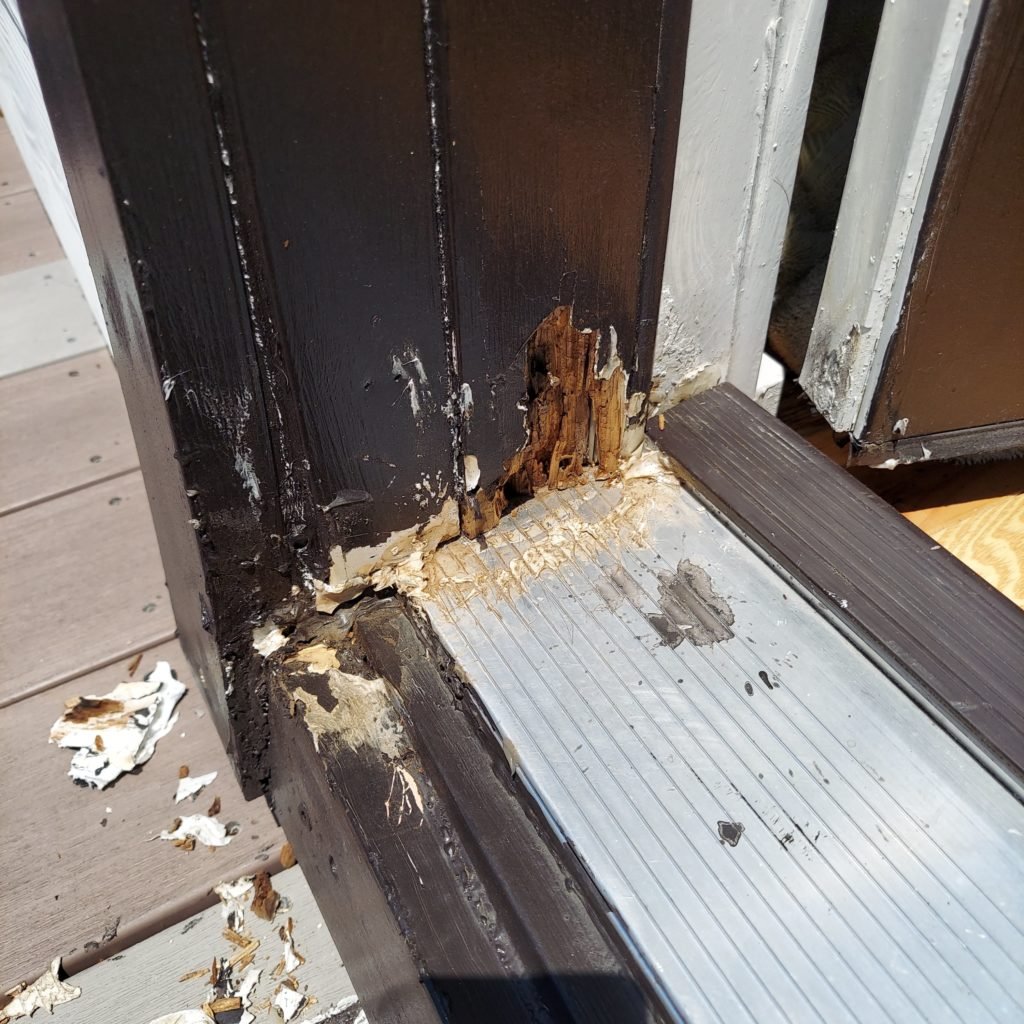
The report also identified inadequate training of inspectors as a consistent problem: Rather than interactive exercises, most of the onboarding consists of a virtual presentation with long lists of code requirements interspersed with stock photos. The result? Inspectors who often can’t catch deeper structural problems. “They send the lowest-certified people out there to look at illegal construction,” Englebert says. “They don’t know the implications of what they see.”
Mendelson says the DC Council plans to conduct a similar review of illegal construction. DOB did not respond to a list of Washingtonian questions about the condo, Englebert’s allegations, and construction oversight.
After Englebert’s report, she and the Komljenovics secured a new DCRA inspection in July 2021. The agency acknowledged the severity of the building’s problems and issued the current homeowners an “order to correct” structural issues—in other words, requiring the siblings and their neighbors to fix the problems. After another inspection, the agency revised its assessment and sent the correction order to Seifu and a Sushner-owned LLC that was used to sell the property—an unusual step, given that neither of their names was still on the property. Issued on December 2, 2021, the order required Seifu and the LLC to submit plans and a timeline within 20 days for remedies to permanently fix the building’s code violations and render it safe. More than two years later, Seifu has submitted plans, but no corrective work has been done.
The correction order is currently being contested through DC’s Office of Administrative Hearings. In early April, OAH held an evidentiary hearing to determine whether the order can be enforced by the attorney general’s office despite being issued, atypically, to the builder rather than the owner. No ruling has yet been made. If enforceable, the order could take months or years to enact; if not, condemning the building might be the only option. “Nothing guarantees that they won’t condemn the building this year or five or ten years down the road,” Nick says.
Seeking more immediate recompense, the Komljenovics and their downstairs neighbors filed a civil lawsuit against Seifu and Sushner in January 2022, claiming breach of warranty, fraud, and property damage. Seifu defends his and Sushner’s efforts to respond to the correction order. He says the homeowners are being unreasonable and that their lawsuit is an effort to win a large amount of money from Sushner, whom he describes as a “very high-net-worth guy.”
For the siblings and their neighbors, the legal process has been frustrating and discouraging. They feel lost in both the litigation and the correction-order proceedings, in over their heads. “There’s not an adult in the room at any point telling you that everything’s going to be okay,” Nick says.
Because of a clause in their condo owners’ agreements, they were forced to enter into private arbitration with Sushner, the seller. In October, the LLC that Sushner used to sell the Georgia Avenue property filed for bankruptcy, and in March, an arbitrator ruled against the homeowners, determining that Sushner cannot be held personally liable for necessary repairs because the LLC shielded him from responsibility. After initially telling Washingtonian he wasn’t permitted to talk about the building because of the lawsuit, Sushner did not respond to repeated interview requests.
The suit against Seifu is still pending, but Nick and Darinka aren’t optimistic about its outcome. The builder’s various LLCs could make it harder for both the homeowners and the city to pursue him, and he has continued to build: Last July, DOB issued a stop-work order to a Seifu-owned LLC that was putting up a 20-unit mixed-use tower in Tenleytown, for failing to notify officials when construction reached a point requiring city inspection. The LLC was ultimately fined $2,358. Another Seifu multifamily building is under construction at 1544 Rhode Island Avenue, Northeast.
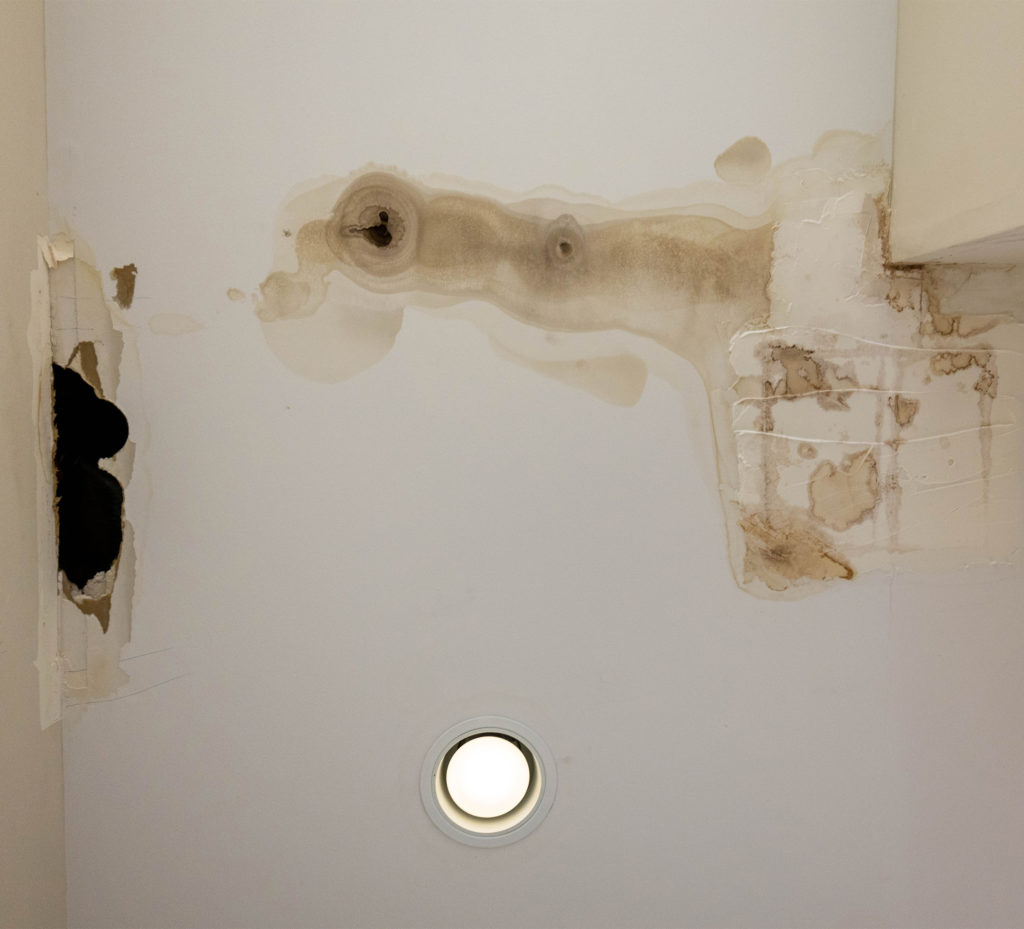
Currently, the Komljenovics and their neighbors still live in their condos. They say new leaks continue to cause ceiling damage, the building’s swaying has only worsened, and all four regularly leave at night during storms. The homeowners all have insurance, but their policies cover only unforeseen “acts of God,” not construction issues. In their lawsuit, they allege that the warranty bond on the building was worth only $25,000—a fraction of the money needed to make meaningful repairs. In response to the correction order, Seifu suggested a plan to retrofit the building with a structure called a moment frame that would create more bracing. A report from architect Jeremy Busse of the firm Advanced Building Design, hired by Nick, concluded that the $1.5 million cost of doing so would be more expensive than demolishing, redesigning, and reconstructing the building from the ground up.
Depending on the outcome of litigation, that cost could fall on the homeowners. Nick finds himself occasionally overwhelmed by feelings of injustice. “We have been moving since I was ten years old,” he says. “I’ve lived 15 to 20 different places. Finally, I was about to settle and put some roots down, and it all just blows up.”
The siblings continue to pay their mortgage. So do their neighbors. Meanwhile, the cracks in their walls keep growing. The whole experience, they say, has soured them on the city—and if they can ever manage to sell their condos, all four plan to move to Maryland or Virginia. “I’ve always been a huge advocate for DC, and I really thought this was going to be my forever home,” Darinka says. “After these last three years, I can’t stand this place anymore.”
This article appears in the May 2024 issue of Washingtonian.
